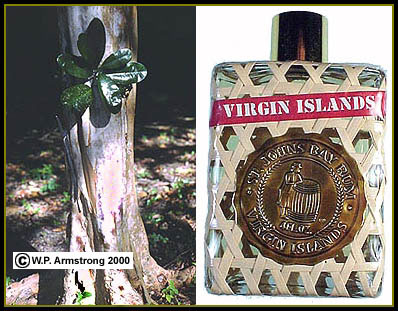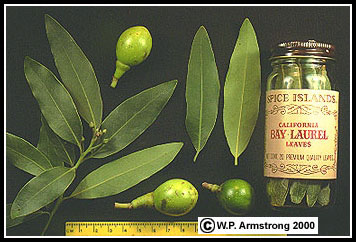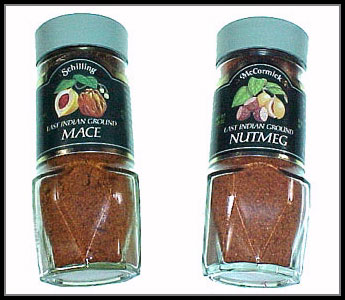|
Allspice comes from the dried, green berries of Pimenta dioica, a central American tree of the myrtle family (Myrtaceae). It is also known as pimento; however, the red pimentos that are stuffed into green olives are actually a variety of sweet chile pepper (Capsicum annuum) that belongs to the nightshade family (Solanaceae). The name "allspice" refers to the flavor of the berries, which resemble a combination of cinnamon, nutmeg and cloves.

|
Allspice (Pimenta dioica), a Central American spice tree. The dried berries have the flavor of cinnamon, nutmeg and cloves.
|
Cloves (Syzygium aromaticum)
Cloves (Syzygium aromaticum) are native to the Spice Islands of the East Indies and belong to the same family as allspice, the Myrtaceae. In fact, they belong to the same genus as the Australian brush cherry (S. paniculatum), a commonly cultivated small tree or shrub in southern California. Also in this genus is the rose apple (S. jambos), a popular West Indian fruit that is native to southeast Asia. Unlike cinnamon and nutmeg, the clove spice comes from dried, unopened flower buds. Clove oil is extracted from the buds, stems and leaves, and is used in the perfume and soap industries and as a naturopathic, temporary remedy for tooth aches. Up to 80-95 percent of clove oil contains eugenol, a phenolic essential oil. Useful essential oils from the myrtle family may be phenolic or terpene derivatives, depending on the species.

|
Cloves are the sun-dried, flower buds of (Syzygium aromaticum), a tree native to the Molucca Islands between Celebes and New Guinea (also known as the Spice Islands).
|

|
Clove oil has antibacterial and painkilling (anesthetic) properties. When applied directly to the gums, it will numb the pain of toothache. A mouthwash containing clove oil has been shown to be effective in treating gingivitis.
|
Bay Rum (Pimenta racemosa)
Bay rum is obtained from the distillation of the leaves of Pimenta racemosa, a tree native to the West Indies. The bay rum tree belongs to the same genus as allspice, both members of the myrtle family (Myrtaceae). It contains a phenolic essential oil used in lotions and colognes. The fragrant oil superficially resembles clove oil, another tree in the myrtle family. The name bay "rum" comes from the former practice of distilling bay in rum and water. It is NOT consumed internally as in the highly intoxicating sugar cane beverage known as rum.

|
Left: Shiny green leaves and trunk of the ray rum tree (Pimenta racemosa) on the island of St. John, U.S. Virgin Islands. Right: Bottle of fragrant bay rum cologne (not to be confused with sugar cane rum).
|
Caper Family (Capparaceae)
Capers (Capparis spinosa)
Like cloves, the tasty "spice" called capers (Capparis spinosa) also comes from unopened flower buds. The caper plant is a low, trailing shrub in the caper family (Capparaceae) native to the Mediterranean region. Also known as Capparidaceae, the caper family is a small plant family closely related to the mustard family (Brassicaceae). It includes an interesting native southern California shrub called bladderpod (Isomeris arborea). Capers are used mainly for flavoring pickles, relishes and sauces. Their salty flavor truly enhances swordfish steaks and pasta (spaghetti) dishes.

|
Capers are the pea-sized, unopened flower buds of Capparis spinosa (Capparidaceae), a trailing shrub of the Mediterranean region. They are used to flavor pickles, relishes and sauces, and are absolutely delicious on swordfish steaks and in pasta (spaghetti) dishes.
|
|
Caper (Capparis spinosa), a trailing shrub of the Mediterranean region. The image shows a long-stalked fruit (berry) and the typical flat, oval leaves. The showy white flowers have numerous stamens. Capers of commerce come from the pea-sized, unopened flower buds of this species. They are used to flavor pickles, relishes and sauces, and are commonly used in pasta (spaghetti) dishes.
|
Laurel Family (Lauraceae)
True cinnamon comes from the bark of the cinnamon tree (Cinnamomum zeylanicum), a member of the Laurel Family (Lauraceae). Another species of Cinnamomum (C. camphora) is the source of camphor oil, a monoterpene essential oil distilled from the twigs, leaves and wood. Camphor oil is used in antiseptics and in pain-relieving creams, gels and lotions. Along with menthol, it is the active ingredient in aromatic analgesic ointments for nasal decongestion and muscular aches and pains.
Camphor (Cinnamomum camphora)

|
Camphor tree (Cinnamomum camphora): The source of camphor oil, a monoterpene essential oil used in topical antiseptics and aromatic analgesics.
|
Cinnamon (Cinnamomum zeylanicum)

|
The cinnamon tree (Cinnamomum zeylanicum), a member of the laurel family (Lauraceae). The delicious, fragrant spice cinnamon is obtained from the ground inner bark of trunks and branches. Another species of Cinnamomum (C. camphora) is the source of camphor oil, a monoterpene essential oil distilled from the wood. Both species of Cinnamomum are native to rain forests of tropical Asia.
|
Bay Leaves (Umbellularia californica)
Other important fruit and herbal trees in the laurel family include avocado (Persea americana), sassafras (Sassafras albidum), European bay (Laurus nobilis), and California bay or Oregon myrtle (Umbellularia californica). Nutmeg spice comes from the dried endosperm inside the seed of the nutmeg tree (Myristica fragrans), a member of the myristica family (Myristicaceae). California nutmeg (Torreya californica), a native tree in the Sierra Nevada, is actually a gymnosperm that belongs to the yew family (Taxaceae). Its large seeds, with a fleshy green outer layer, superficially resemble those of the true nutmeg tree.

|
Dried leaves of the California bay tree (Umbellularia californica) are used as a delicious herb in spaghetti and other entrees. The fruits resemble miniature avocados. The light-colored wood from large trees in Oregon (known as Oregon myrtle) has a beautiful grain and is made into various objects, such as furniture and bowls.
|

|
Dried leaves of the California bay tree (Umbellularia californica) are used as a delicious herb in spaghetti and other entrees. The fruits resemble miniature avocados (also in the Lauraceae), with a large seed surrounded by an outer, green fleshy layer.
|
Sassafras (Sassafras albidum)
Sassafras oil is an important flavoring obtained from distillation of the bark on the roots of Sassafras albidum, a large tree native to the deciduous forest biome of the eastern United States. This tree is unmistakable with its large, three-lobed leaves that turn golden yellow during the fall months. Sassafras is widely used for flavoring tobacco, carbonated beverages, medicines, soaps, perfumes, dentrifices and sassafras tea. Although sassafras has also been used to flavor root beer, the primary flavorings used in the original recipes for old-fashioned root beer come from an infusion of the roots, bark and leaves of sarsaparilla, ginger and wintergreen. Sarsaparilla comes from the roots of Smilax species, such as S. offinicalis (Liliaceae), while ginger comes from the rhizome of Zingiber officinalis (Zingiberaceae). Oil of wintergren is derived synthetically and from the distillation of leaves from Gaultheria procumbens (Ericaceae). Like many other beverages sold today, most of the popular root beers contain synthetic flavorings.
|
Sassafras (Sassafras albidum) is a beautiful tree native to the deciduous forest biome of the eastern United States. It is readily identified by its large three-lobed leaves. Sassafras oil is obtained from the roots and is used in carbonated beverages, teas, medicines and perfumes.
|
Nutmeg Family (Myristicaceae)
Nutmeg (Myristica fragrans)

|
Dehiscent fruit of the nutmeg tree (Myristica fragrans) showing the large seed surrounded by a red, fleshy, netlike aril. The spice called mace is derived from the fleshy aril. Nutmeg is derived from the ground seed endosperm. Some authors consider this fruit to be a drupe that splits open at maturity, exposing a hard, black endocarp layer surrounded by the fleshy red aril. This is the only tropical fruit that is the source of two different spices. Note: The chemical spray used in self defense and riot control is not derived from the mace of nutmeg fruits.
|

|
Mace and nutmeg, two important spices from the fruit of the nutmeg tree (Myristica fragrans). Mace is derived from the fleshy red aril surrounding the seed, while nutmeg is derived from the ground seed endosperm. This is the only tropical fruit that is the source of two different spices. Note: The chemical spray used in self defense and riot control is not derived from the mace of nutmeg fruits.
|
Witch-Hazel Family (Hamamelidaceae)
Witch Hazel (Hamamelis virginiana)
Witch hazel (Hamamelis virginiana) is shrub in the witch-hazel family (Hamamelidaceae) native to the eastern United States. The witch hazel of commerce is an aromatic mixture of tannin and a phenolic essential oil (hamamelitannin) obtained from the distillation of the leaves, bark and twigs of this interesting shrub. Liquidambar or sweet gum (Liquidambar styraciflua), a commonly cultivated deciduous tree with beautiful autumn foliage, also belongs to this family. The common name "witch hazel" is derived from the custom of using its branches as divining rods to reveal hidden underground water, a practice known as water witching. This shrub also has the curious adaptation of forcibly ejecting its shiny black seeds (two seeds per capsule) when the seed capsules are ripe. Witch hazel is used medicinally as a soothing, topical astringent. One of its best-known uses is in medicated pads for the relief of hemorrhoids. For this purpose it is unsurpassed by any naturopathic remedy.

|
The foliage and seed capsules of witch hazel (Hamamelis virginiana) in the fall. Two shiny black seeds are forcibly ejected from each capsule, a fact verified by Mr. Wolffia one evening when he placed a branch on the night stand next to his bed.
|
|